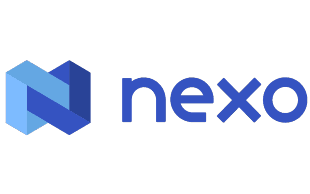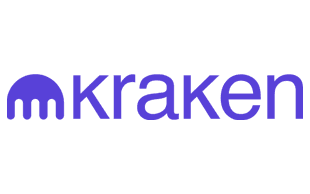Disclaimer: This page is not financial advice or an endorsement of digital assets, providers or services. Digital assets are volatile and risky, and past performance is no guarantee of future results. Potential regulations or policies can affect their availability and services provided. Talk with a financial professional before making a decision. Finder or the author may own cryptocurrency discussed on this page.
Each year, we conduct a comprehensive review of crypto staking and rewards platforms. To arrive at these picks, we’ve compared more than 30 platforms on things like annual percentage yield (APY), how yield is generated, user experience, range of assets and risk mitigation tools.
Before you begin, it’s important to understand that crypto platforms generate yield in several different ways, each with different levels of risk attached. Any time you give up the private keys to your assets, you technically lose your ability to access them. Keep this in mind before lending them to a third party.
The following are platforms that can help you earn crypto via staking, lending and decentralized finance (DeFi).
Best crypto staking and rewards platforms of 2025
- Nexo – Best platform (overall)
- Kraken – Best for off-chain staking
- Gate.io – Best for range of staking assets
- Binance – Best for flexible staking periods
- Crypto.com – Best crypto staking broker
- Ledger Nano S Plus – Best hardware wallet for crypto staking
- Aave – Best DeFi staking platform
Must read: Staking vs. lending
Lending involves you depositing crypto to an exchange or platform’s lending pool. These assets are then lent out to borrowers at a fixed or variable rate. The platform keeps a commission for acting as a third party during this process, while you are paid out the remaining yield.
On-chain lending involves you lending your crypto tokens via a decentralized finance (DeFi) protocol. To do this, you’ll need to use a non-custodial wallet and know how to interact with a DeFi protocol.
Traditional on-chain staking involves locking up your cryptocurrency in a smart contract that is governed by the network’s proof-of-stake consensus. These assets are used by the blockchain to secure the network, confirm transactions and generate new blocks. New coins are distributed to stakers.
Off-chain staking differs from traditional staking in that it doesn’t involve direct interaction with the blockchain. Instead, you deposit your assets on an exchange or platform that acts as a middleman and stakes on your behalf. This is sometimes referred to as “staking-as-a-service”.
1. Nexo – Best platform (overall)
Nexo Cryptocurrency Exchange
Supported cryptos
Fiat currencies
How yield is generated: Lending
Nexo offers competitive rates on major cryptocurrencies with industry-leading risk management, is suitable for both beginners and advanced users and comes complete with exchange features. That's why it's our pick for the best overall platform for earning yield.
While many lending platforms see rewards fluctuate over time – sometimes daily – Nexo's rates are relatively stable and you can easily estimate your returns using the website's yield calculator.
Another stand-out feature of the Nexo platform is its risk management practices. Over-collateralized loans mean that borrowers must deposit more funds than they borrow, which ensures that lenders take on minimal risk. Lenders are also covered by Nexo's insurance policy in the event of a hack, theft or loss of private keys.
As an incentive to increase your reward rate and balance limits, Nexo uses a tiered loyalty structure. In order to receive higher returns and balance limits, lenders are encouraged to hold a percentage of their portfolio in the NEXO token, which also generates yield.
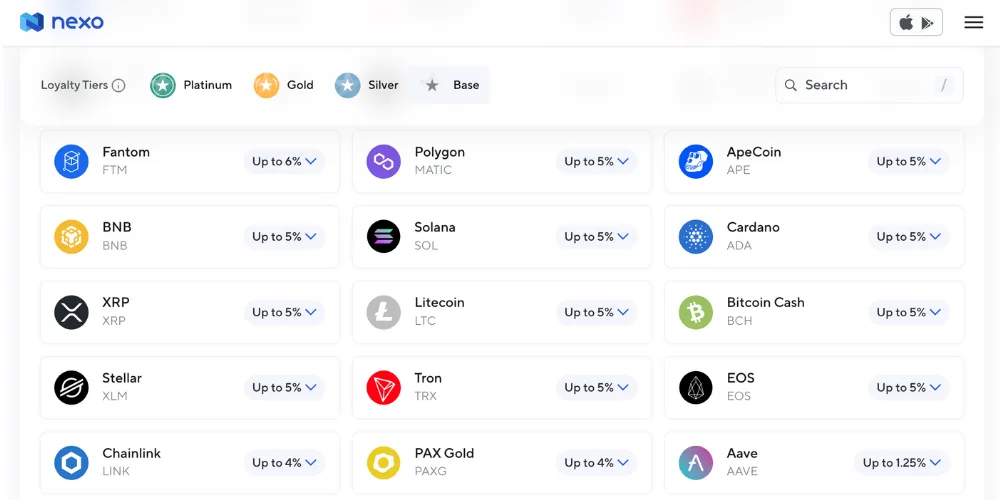
- Beginner-friendly platform with consistently competitive APYs
- Earn yield on fiat deposits as well as crypto
- Industry-leading security standards and insurance policies
- Offers exchange services and a debit card for spending crypto
- Enables you to take out loans against your crypto assets
- Not available to US customers
- Must hold a percentage of portfolio in NEXO to receive highest APY
- Less yield-earning cryptos than some competitors
| Deposit methods | Bank transfer, Cryptocurrency, Credit or Debit Card |
|---|---|
| Deposit fees | None |
| Withdrawal fees | None (Blockchain gas fees apply) |
| Trading fees | Maker: 0-0.3% Taker: 0.08-0.4% |
2. Kraken – Best for off-chain staking/staking-as-a-service
Kraken Cryptocurrency Exchange
Supported cryptos
Fiat currencies
How yield is generated: Off-chain staking
Kraken differs from many other staking platforms in that it mainly supports off-chain staking to generate yield.
Staking utilizes the blockchain's proof-of-stake consensus mechanism. By locking up eligible cryptos, node operators are helping to secure the network and in turn are rewarded when new blocks are generated.
To partake in this, you lend your assets to Kraken, and they stake them for you.
This method of generating a yield with crypto substantially reduces the counterparty risk when compared with other yield-generating products like lending.
Kraken currently supports on-chain staking for 19 cryptos and offers returns over 20%, which makes it our top pick in this category.
Launched in 2013, Kraken is one of the oldest cryptocurrency exchanges and has a strong focus on high-end security and legal compliance.
Unfortunately, Kraken can't offer its staking feature to US customers due to regulatory issues.
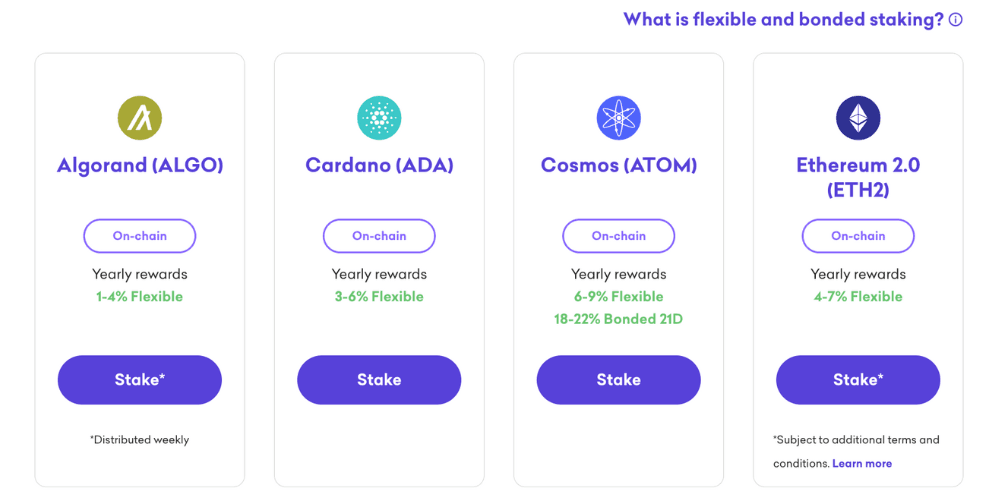
- No waiting or bonding periods
- Payouts twice weekly
- No fees or fixed lock-up durations
- Staking available via the Kraken website or mobile app
- Stopped staking service in the US in February 2023 and facing regulatory scrutiny in other markets
- Fewer cryptos available for staking than competitor lending services
- ETH staking is more complicated and can result in admin fees and waiting periods
- Lower rewards than running a node yourself because Kraken takes a commission
| Deposit methods | Bank transfer, Credit card, Cryptocurrency, Debit card, Apple Pay, Google Pay, SWIFT |
|---|---|
| Deposit fees | Fees vary |
| Withdrawal fees | Fees vary |
| Trading fees | Maker: 0.00-0.16% Taker: 0.10-0.26% |
3. Gate.io – Best range of assets and earning options
Gate.io Cryptocurrency Exchange
Supported cryptos
Fiat currencies
How yield is generated: Varies
Gate.io is our stand-out in this category thanks to the multiple earning products and range of assets it offers. Popular Gate.io earning products include:
- HODL & Earn. Subscription to a pool requires locking up your crypto for 7–14 days. APRs range from 0.5% to 1.5%.
- Single-asset vaults. Lend your crypto to borrowers and earn a percentage reward for doing so. Single-asset vaults support hundreds of coins and tokens and APRs of +150% are not uncommon.
- Dual currency liquidity mining. Gate.io offers liquidity mining on hundreds of trading pairs. Centralized exchange liquidity pools work in much the same way as on DeFi exchanges. Liquidity mining carries the risk of impermanent loss and this should be carefully considered when calculating APRs – higher return rates equate to a higher chance of impermanent loss.
Gate.io also features cloud mining, dual currency products and copy trading.
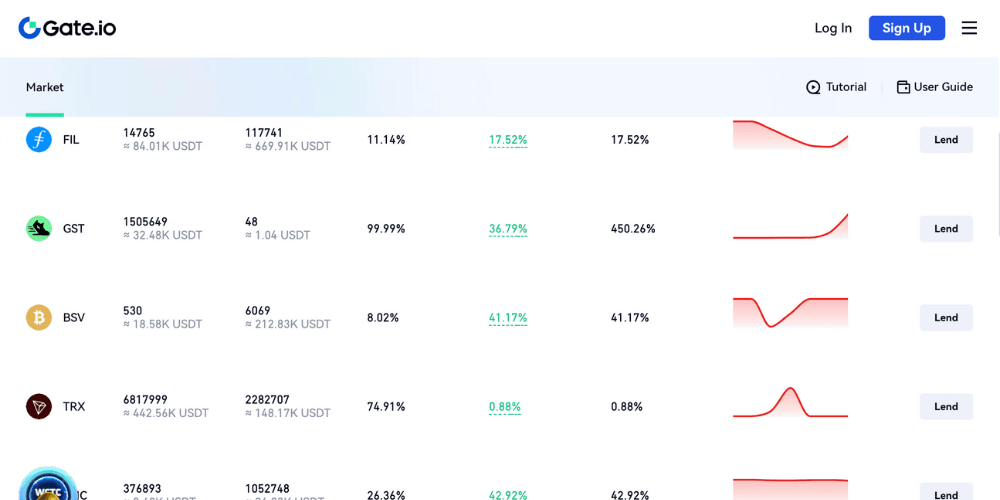
- Multiple ways to earn with a range of low- and high-risk products
- Hundreds of cryptos supported for single-asset vaults and dual currency liquidity mining
- Opportunities to earn on low-cap cryptos
- No DeFi knowledge required
- No need to use a non-custodial wallet
- Not available to US customers
- Popular HODL &
- Earn pools can sell out quickly
- Liquidity pool APRs fluctuate daily and can be volatile depending on fund utilization rate
- Liquidity mining carries the risk of impermanent loss
| Deposit methods | Bank transfer, Credit card, Cryptocurrency, Debit card |
|---|---|
| Deposit fees | None |
| Withdrawal fees | Fees vary |
| Trading fees | Maker: 0.30% Taker: Varies |
| Advanced Trading Features | Yes |
4. Binance – Best for flexible staking periods
Binance Cryptocurrency Exchange
Supported cryptos
Fiat currencies
How yield is generated: Varies
The option to choose between short- and long-term lock-up periods makes Binance our top pick for flexible staking.
Binance supports staking on 350+ cryptocurrencies and offers attractive APRs on some tokens. Staking durations range from 7–120 days and require low minimum token balances to start earning. Keep in mind that staking durations differ between tokens and pools can sell out at Binance's discretion.
If you choose to remove your funds before the lock-up period ends, your assets will be refunded into your Binance spot account. Early redemption will result in the APR accrued being deducted from your initial investment.
DeFi staking is also supported. This is the process in which Binance, by proxy, stakes your assets in on-chain yield earning pools. Binance's DeFi staking works in a similar manner to its traditional staking services. However, Binance claims it will 'not assume liability for any losses incurred due to project on-chain contract security issues'.
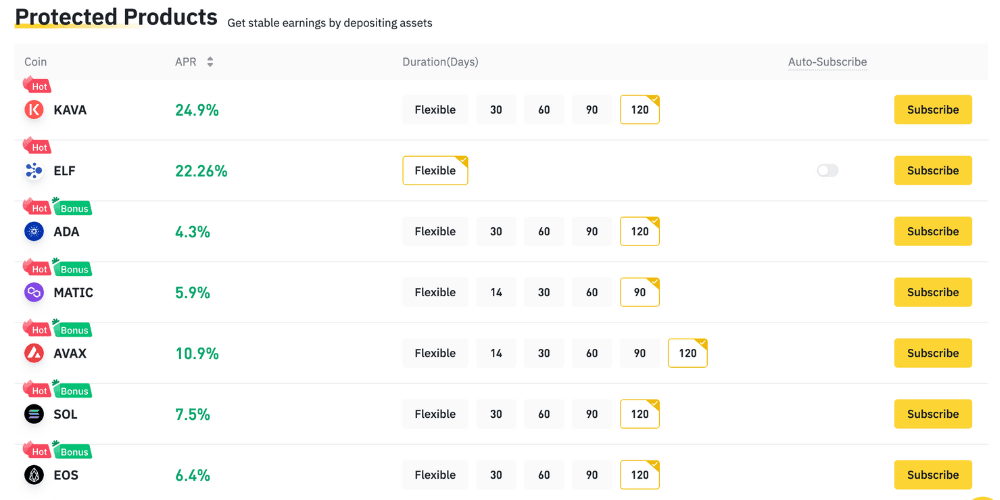
- 350+ coins and tokens supported for staking
- DeFi staking supported
- Low minimum token balance required
- Lock-up durations of 7 to 120 days
- High yield rates
- Not available to US customers
- Early redemption results in a loss of yield accrued
- Staking pools can sell out
- Binance is not liable for losses incurred in DeFi staking pools
| Deposit methods | Bank transfer, Credit card, Cryptocurrency, Debit card, P2P |
|---|---|
| Deposit fees | None |
| Withdrawal fees | Fees vary |
| Trading fees | 0-0.1% |
| Advanced Trading Features | Yes |
5. Crypto.com – Best staking broker
Crypto.com App
Supported cryptos
Fiat currencies
States supported (incl. CA, FL, HI, TX)
How yield is generated: Off-chain staking
Crypto.com offers staking APRs on dozens of popular cryptocurrencies. This wide range of assets with flexible length lock-ups and an easy-to-use app make Crypto.com our pick for the best crypto staking broker.
Crypto.com offers staking deposit durations of 1 and 3 months, as well as a flexible term option. Rewards are paid out in the same currency that you used to stake and are transferred to your crypto wallet every 7 days.
Rewards are calculated based on a tiered loyalty structure – you must stake a certain amount of Crypto.com's native coin, CRO to receive the highest APR. You can estimate your rewards through the website's earn calculator.
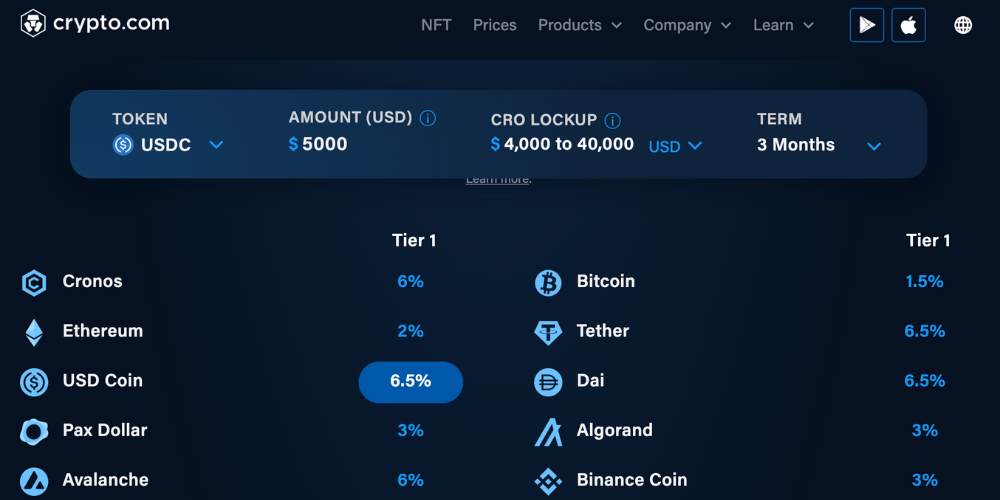
- Easy-to-use app
- Earn staking rewards on dozens of cryptos
- Rewards paid weekly to your Crypto.com wallet
- Flexible staking durations
- Tiered structure. Less CRO staked equates to a lower APR
- Desktop support not available
| Deposit methods | Bank transfer, Credit card, Debit card, PayPal, Wire transfer, Fedwire, Apple Pay, Google Pay, SWIFT |
|---|---|
| Deposit fees | None |
| Withdrawal fees | Fees vary |
| Trading fees | Maker fees: 0% to 0.25% Taker fees: 0.5% to 0.15% |
- AL
- AK
- AZ
- AR
- CA
- CO
- CT
- DE
- FL
- GA
- HI
- ID
- IL
- IN
- IA
- KS
- KY
- LA
- ME
- MD
- MA
- MI
- MN
- MS
- MO
- MT
- NE
- NV
- NH
- NJ
- NM
- NC
- ND
- OH
- OK
- OR
- PA
- RI
- SC
- SD
- TN
- TX
- UT
- VT
- VA
- WA
- WV
- WI
- WY
6. Ledger Nano S Plus – Best staking wallet
Ledger Nano S Plus Wallet
Finder score
Price (USD)
Assets
Wallet type
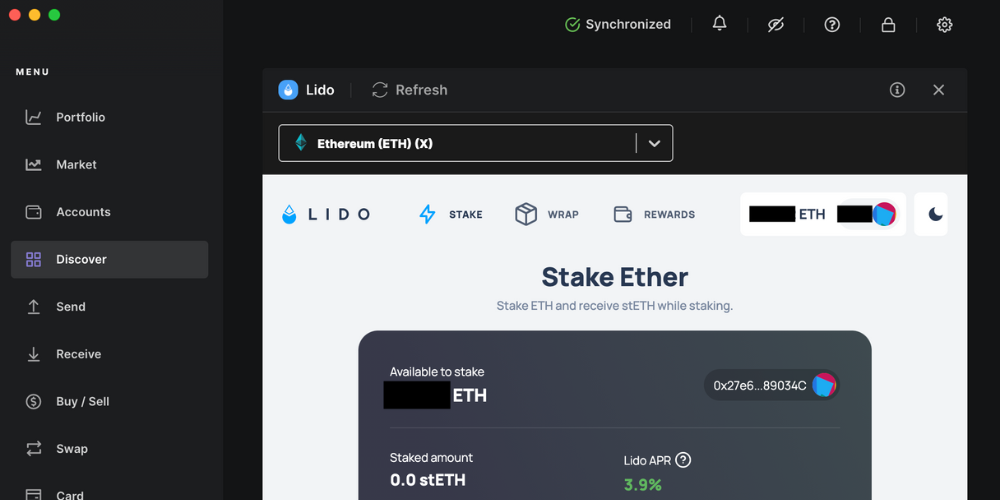
- Earn yield while knowing your crypto is secured in cold storage
- Stake directly through your favorite project's software wallet, or via Ledger Live
- Safely store all of your digital assets in one location
- Rewards paid directly into your Nano S Plus wallet
- List of yield-earning cryptos is not as comprehensive as some exchanges or wallets
- On-chain staking can require a more advanced knowledge than a simple 'click-to-earn' platform
- Management and security of staked assets falls on you as the owner of the wallet
7. Aave – Best DeFi lending platform
How yield is generated: On-chain lending
Aave lets users make the most of decentralized finance while keeping things simple. That’s why it’s our top pick for DeFi lending.
Aave’s lending platform allows users to deposit cryptocurrency into the Aave Liquidity Protocol. These assets are lent to borrowers in the form of a “crypto loan”. Borrowers pay a stable or variable rate, of which Aave keeps a percentage, while the remainder is paid to lenders at an algorithm-decided APY.
Aave differs from many DeFi platforms in that it doesn’t support liquidity pools, but instead single-asset lending. This makes it one of the more simple DeFi protocols, as it can be used by lenders looking to earn yield without having to worry about impermanent loss.
It does this using a process known as collateralized lending. In order to borrow, you must first supply an asset to be used as collateral. Any supported crypto can be used; however, if a liquidation threshold is reached, your assets will be sold and returned to lenders. This entire process is secured by smart contracts to ensure that lenders never end up out of pocket.
Pros
- Single asset lending – no impermanent loss
- 7 blockchains supported in V3
- Collateralized lending
- Consistently ranked top 3 Ethereum-based DeFi protocols by total value locked (TVL)
- No fixed-length loans
Cons
- APY lowers as utilization rate increases
- Fewer coins and tokens supported than some competitor DeFi platforms
- Staking only available for native AAVE token
What is a crypto staking platform?
Crypto staking platforms let you deposit your digital assets with them in exchange for rewards.
This reward – or yield – can be generated via staking, lending or through DeFi. Some services may even use a combination of these methods to provide you with yield. Each method has its own unique risk profile, so it’s important to understand how each works before you decide which platform is right for you.
On-chain staking
This involves locking up a blockchain’s native coin which is then used in proof-of-stake (PoS) consensus to secure the blockchain. Staked funds are used as collateral, which allows the staker to act as a network validator: confirm transactions, secure the network against malicious nodes and generate new blocks. In return for providing these services, the staker is rewarded with freshly minted coins.
On-chain staking is considered a relatively safe way to earn yield. This is because the process is largely automated and validators are motivated by rewards to ensure everything goes smoothly. But, if they do the wrong thing or make a mistake, they can receive a slashing penalty in which a portion of the collateral is lost.
Dive deeper into crypto staking
Lending
Crypto lending involves asset holders lending coins or tokens to a platform for a fixed or variable period of time. These assets are aggregated and made available to borrowers who pay a fee. This fee is then paid as an annual percentage yield (APY) to lenders.
Many crypto trading platforms now support crypto lending and offer competitive returns for lending your unused assets. The most important thing to understand when lending crypto is the platform’s collateralization model.
Collateralization refers to the amount of capital a borrower has to deposit as collateral, in order to take out the loan. Over-collateralized loans are preferable as they require the borrower to deposit more funds than they are borrowing, which substantially reduces the risk profile for lenders.
Our complete guide to crypto lending
DeFi
Decentralized finance involves using blockchain applications to emulate many of the complex financial services found in traditional finance. At a glance, it can seem quite daunting. However, if responsibly used, it can provide a useful tool for passive income. While DeFi yield earning opportunities are vast, one of the most popular is liquidity mining.
Liquidity mining involves depositing two or more cryptos into a liquidity pool. This liquidity is made available for users of the platform to perform swaps and trades. By doing this you are acting as a liquidity provider (LP). Traders pay fees to use the pool which are distributed as APY to LPs.
Before acting as an LP, it is important to thoroughly understand impermanent loss and the role that this plays in your yield earning potential.
How to choose the best platform for crypto staking rewards
It’s important to research a wide range of platforms and compare the pros and cons of each option. The best crypto staking platform for you depends on what you’re looking for.
How to use a crypto staking platform
Before depositing assets into a staking or lending platform, you should follow a few simple steps to help build an investment strategy:
- Deposit funds. Deposit the asset/s that you intend to invest. Depending on the platform, deposits can be made using fiat or cryptocurrencies.
- Decide on a variable or fixed yield. Variable rates fluctuate based on market conditions and can be hard to calculate over a long period of time. Fixed rates make estimating your returns over a certain period of time a lot simpler. Some platforms even offer a yield earning calculator.
- Select a lock-up duration. Longer lock-up periods often equate to an increased percentage yield. However, consider what crypto you’re holding before committing long term. If you aren’t confident in the project or may need to access your funds at short notice, an anytime withdrawal option is probably best.
- Collect your yield. Some providers distribute your yield on a daily or weekly basis and allow you direct access. Other platforms will auto-compound your returns, reinvesting and increasing your deposited funds until the contract comes to a close. Keep in mind that although some providers distribute yield on a regular basis, they will deduct this from your initial investment for contract breaches such as early termination.
Risks of staking on a crypto platform
There are always risks associated with investing, and crypto staking and lending pools are no exception. Be aware of the risks involved and how best to mitigate them:
- Counterparty risk. Counterparty risk is the chance that a company may default on its contractual obligations. If a platform experiences a financial default, you may lose some or all of your funds. Counterparty risk can be minimized by choosing to earn yield through staking, rather than lending, or choosing a lender with an over-collateralized model. Look for a platform with an insurance policy to cover such events, or transact on-chain with DeFi.
- Yield rates. APYs vary drastically from platform to platform. If you notice a return rate that is “too good to be true”, take the time to understand how and why that rate is offered. Whether it’s a risky project or involves impermanent loss, there is often a reason why such incredible rates are being offered.
- Price volatility. Cryptos are inherently volatile. When planning your staking or lending, take into consideration how your assets might move. If you’re confident in holding your cryptos long term, locked staking or lending might be a suitable way to build up your balance. For higher-risk investments that you might want to sell, a variable-term, early withdrawal option is usually best.
- On-chain earning. Staking and lending directly on-chain requires a solid grasp of how to use non-custodial wallets and make blockchain transfers. If you make a mistake along the way, there is no customer support on offer and all transactions are final. Incorrect usage can result in lost funds.
- Under-collateralized lending. Under-collateralized lending is a high-risk method that counts on the exchange generating profits. If it fails to do so, you’re at risk of losing all of your assets.
- Tax may apply. It may come as a surprise, but crypto transactions made on-chain or through an exchange are generally considered taxable events. Make sure you’re aware of your local tax agency’s treatment of cryptocurrencies, consider tracking your transactions with dedicated crypto tax software and consult a financial advisor if you’re unclear.
Methodology
We reviewed data from 30 different cryptocurrency staking and lending platforms to identify the best services globally. When assessing each platform, we looked at:
- Source of yield. How yield is generated is a large point of difference between providers, and various methods have different consequences in terms of risk.
- APYs. Bigger is not always better when it comes to yield rates. We rewarded providers that showed sustainable and low-risk sources of yield.
- User experience. We took a hands-on approach and used each of the platforms reviewed to get an idea of ease-of-use and all-round user experience.
- Transparency. We rewarded businesses that were transparent about their business practices, including how yield is generated, risk mitigation and insurance policies.
- Counterparty risk. What liabilities the company has, particularly in regards to what risks user assets are exposed to in order to generate yield, was our main criteria in this section.
- Regulatory environment. We considered where the business is based and what regulations it complies with at home and aboard.
- Number of assets. We reviewed the number and quality of digital assets on offer.
- Security. We factored in the platform’s security practices as well as its historical track record for things like hacks or data breaches.
Bottom line
There are lots of ways to put your cryptos to work and potentially earn attractive rewards for doing so.
Risk tolerance is the biggest thing to consider when you’re deciding on the best place to stake your crypto. Traders looking for higher risk and higher rewards may be more inclined to delve into the world of DeFi. Those happy to earn consistent and relatively stable returns might opt for on-chain staking or a crypto lending platform with a sound insurance policy and lending model.
While there is no perfect way to earn yield on your crypto, proper planning and research can help you build a solid investment plan, take confidence in your strategy and let your assets do the work for you.
Frequently asked questions
Sources
Disclaimer: Cryptocurrencies are speculative, complex and involve significant risks – they are highly volatile and sensitive to secondary activity. Performance is unpredictable and past performance is no guarantee of future performance. Consider your own circumstances, and obtain your own advice, before relying on this information. You should also verify the nature of any product or service (including its legal status and relevant regulatory requirements) and consult the relevant Regulators' websites before making any decision. Finder, or the author, may have holdings in the cryptocurrencies discussed.
Ask a question
More guides on Finder
-
9 legitimate ways to get free crypto
Here are some legitimate ways to earn free crypto. See which methods interest you, find out how to get started and grow your digital wallet.
-
Yield farming: A beginner’s guide
Put those cryptocurrency assets to work in the DeFi sector with yield farming.
-
7 Ways to Earn Passive Income with Crypto
Compare staking, interest, cash back and DeFi tools to earn passive income with cryptocurrency.


